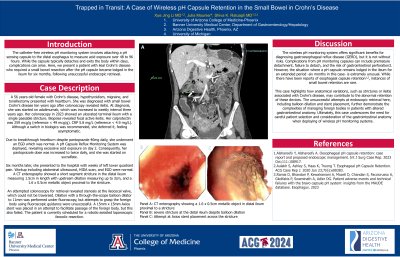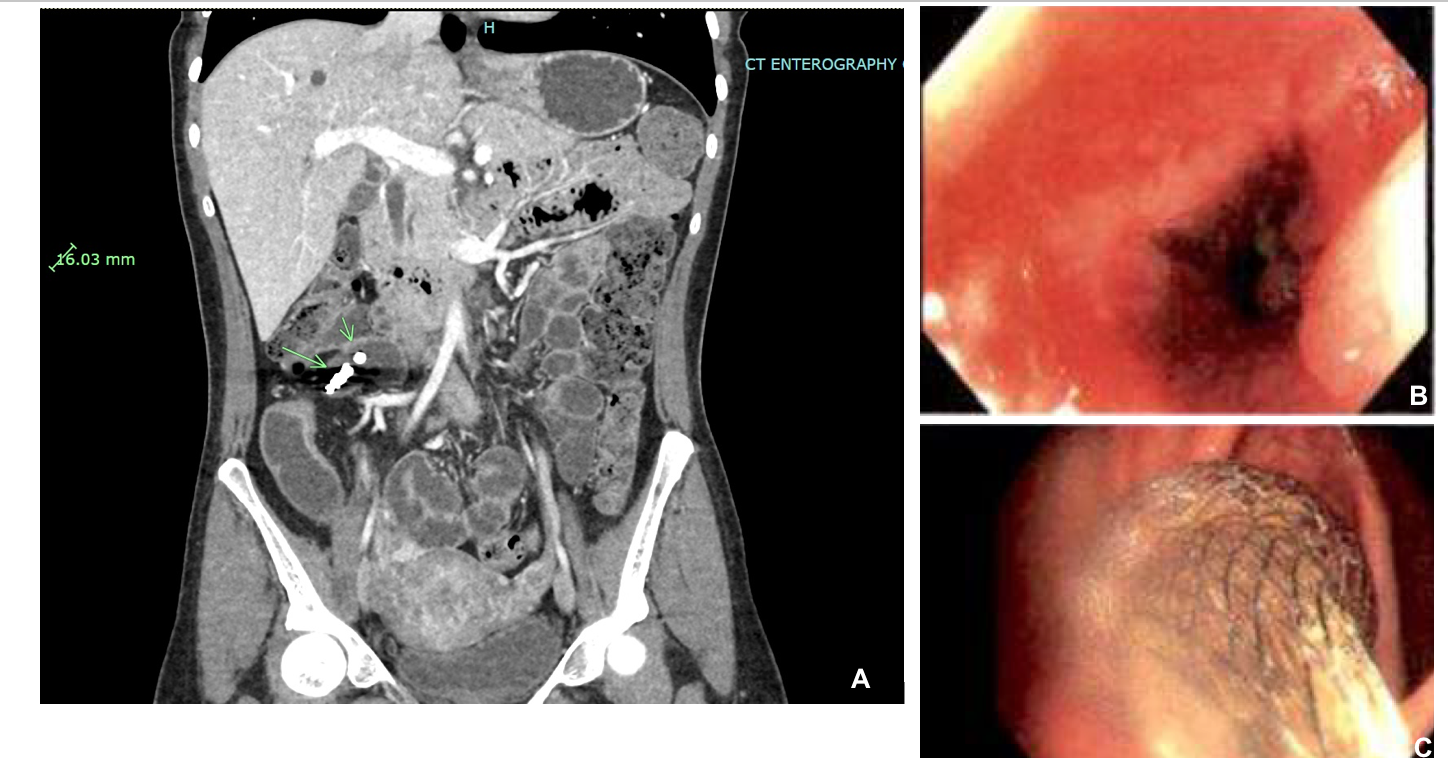Tuesday Poster Session
Category: Small Intestine
P4978 - Trapped in Transit: A Case of pH Capsule Retention in the Small Bowel
Tuesday, October 29, 2024
10:30 AM - 4:00 PM ET
Location: Exhibit Hall E

Has Audio
- XL
Xue Jing Li, MD
University of Arizona College of Medicine, Phoenix VA Medical Center
Phoenix, AZ
Presenting Author(s)
Xue Jing Li, MD1, Julia Mounier, 2, Shiva Ratuapli, MD3
1University of Arizona College of Medicine, Phoenix VA Medical Center, Phoenix, AZ; 2University of Michigan, Phoenix, AZ; 3University of Arizona College of Medicine, Phoenix VA Medical Center, Scottsdale, AZ
Introduction: Catheter-free wireless pH monitoring system involves attaching a pH sensing capsule to the distal esophagus to measure acid exposure over 48-96 hours. Typically, the capsule detaches and exits the body within days, but complications like premature detachment, failure to detach, tears, bleeding, perforation may occur. Here, we present a patient with ileal Crohn’s disease who required a small bowel resection after the pH capsule remained stuck in the ileum for six months and failed endoscopic retrieval.
Case Description/Methods: A 56 years-old female with Crohn’s disease, hypothyroidism, migraine, s/p tonsillectomy presented for heartburn. She was diagnosed with small bowel Crohn’s disease ten years ago after colonoscopy revealed ileitis. She was started on adalimumab, which was increased to weekly interval three years ago. Her colonoscopy a year ago showed an ulcerated terminal ileum with a single passable stricture. Biopsies revealed focal active ileitis. Calprotectin was 259 mcg/g (reference < 49). CRP 5.8 mg/L (reference < 4.9). Patient was recommended to switch biologics, but deferred at she felt asymptomatic.
Due to breakthrough heartburn despite pantoprazole 40mg daily, she underwent an EGD which was normal. A pH Capsule Reflux Monitoring System was deployed, which revealed excessive acid exposure on day 2. Pantoprazole was increased to twice daily and she was started on sucralfate.
Six months later, she presented to the hospital with weeks of periumbilical pain. Workup including abdominal ultrasound, HIDA, and EGD were normal. A CT enterography showed a chronic short segment stricture at the distal ileum measuring 1.5cm in length with upstream dilation measuring up to 3cm without functional obstruction, and a 1.6 x 0.5cm metallic object proximal to the stricture.
A colonoscopy for retrieval was attempted, which revealed stenosis at the ileocecal valve that was non-traversed. Dilation with a through-the-scope balloon dilator to 11mm was performed under fluoroscopy. Attempts at grasping the foreign body using fluoroscopic guidance were unsuccessful. An 15mm x 15mm Axios stent was attempted to facilitate passage of the foreign body but was unsuccessful. Patient is currently scheduled for robotic-assisted laproscopic ileocolic resection, for capsule retrieval and treatment of the stricture.
Discussion: This case highlights the potential complications of wireless pH monitoring in patients with Crohn’s disease, emphasizing the need for careful patient selection and monitoring for passage.

Disclosures:
Xue Jing Li, MD1, Julia Mounier, 2, Shiva Ratuapli, MD3. P4978 - Trapped in Transit: A Case of pH Capsule Retention in the Small Bowel, ACG 2024 Annual Scientific Meeting Abstracts. Philadelphia, PA: American College of Gastroenterology.
1University of Arizona College of Medicine, Phoenix VA Medical Center, Phoenix, AZ; 2University of Michigan, Phoenix, AZ; 3University of Arizona College of Medicine, Phoenix VA Medical Center, Scottsdale, AZ
Introduction: Catheter-free wireless pH monitoring system involves attaching a pH sensing capsule to the distal esophagus to measure acid exposure over 48-96 hours. Typically, the capsule detaches and exits the body within days, but complications like premature detachment, failure to detach, tears, bleeding, perforation may occur. Here, we present a patient with ileal Crohn’s disease who required a small bowel resection after the pH capsule remained stuck in the ileum for six months and failed endoscopic retrieval.
Case Description/Methods: A 56 years-old female with Crohn’s disease, hypothyroidism, migraine, s/p tonsillectomy presented for heartburn. She was diagnosed with small bowel Crohn’s disease ten years ago after colonoscopy revealed ileitis. She was started on adalimumab, which was increased to weekly interval three years ago. Her colonoscopy a year ago showed an ulcerated terminal ileum with a single passable stricture. Biopsies revealed focal active ileitis. Calprotectin was 259 mcg/g (reference < 49). CRP 5.8 mg/L (reference < 4.9). Patient was recommended to switch biologics, but deferred at she felt asymptomatic.
Due to breakthrough heartburn despite pantoprazole 40mg daily, she underwent an EGD which was normal. A pH Capsule Reflux Monitoring System was deployed, which revealed excessive acid exposure on day 2. Pantoprazole was increased to twice daily and she was started on sucralfate.
Six months later, she presented to the hospital with weeks of periumbilical pain. Workup including abdominal ultrasound, HIDA, and EGD were normal. A CT enterography showed a chronic short segment stricture at the distal ileum measuring 1.5cm in length with upstream dilation measuring up to 3cm without functional obstruction, and a 1.6 x 0.5cm metallic object proximal to the stricture.
A colonoscopy for retrieval was attempted, which revealed stenosis at the ileocecal valve that was non-traversed. Dilation with a through-the-scope balloon dilator to 11mm was performed under fluoroscopy. Attempts at grasping the foreign body using fluoroscopic guidance were unsuccessful. An 15mm x 15mm Axios stent was attempted to facilitate passage of the foreign body but was unsuccessful. Patient is currently scheduled for robotic-assisted laproscopic ileocolic resection, for capsule retrieval and treatment of the stricture.
Discussion: This case highlights the potential complications of wireless pH monitoring in patients with Crohn’s disease, emphasizing the need for careful patient selection and monitoring for passage.

Figure: Panel A: CT enterography showing a 1.6 x 0.5cm metallic object in distal ileum proximal to a stricture/
Panel B: severe stricture at the distal ileum despite balloon dilation /
Panel C: Attempt at Axios stent placement across the stricture
Panel B: severe stricture at the distal ileum despite balloon dilation /
Panel C: Attempt at Axios stent placement across the stricture
Disclosures:
Xue Jing Li indicated no relevant financial relationships.
Julia Mounier indicated no relevant financial relationships.
Shiva Ratuapli indicated no relevant financial relationships.
Xue Jing Li, MD1, Julia Mounier, 2, Shiva Ratuapli, MD3. P4978 - Trapped in Transit: A Case of pH Capsule Retention in the Small Bowel, ACG 2024 Annual Scientific Meeting Abstracts. Philadelphia, PA: American College of Gastroenterology.
